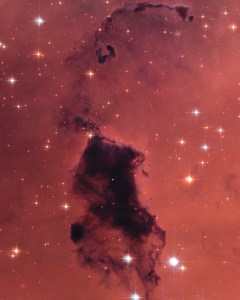We owe pretty much everything to the sun. Its influence upon our planet is tremendous, in cultural/religious ways, but also in terms of how it drives almost every key process here on earth. It would be impossible to list them all, so I will list some of the key ones:
- Photosynthesis. This is the means by which plants use the sun’s energy to produce glucose. Oxygen is a product of this process, and oxygen is obviously very important!
- Atmospheric Effects: Needless to say, the sun’s energy drives atmospheric processes with its constant bombardment of solar rays.
- Light: It goes without saying that without light, the world would be a dark place!
- Heat: The sun provides us with enough heat to keep our water in liquid form and the temperature of the planet at a level we can find comfortable.
What is the sun? How does it work, and how did it come to be?
(a Bok Globule)
Our sun, like virtually all stars, formed out of a molecular cloud or Bok Globule – a gathering of gas and dust that was perturbed by an external event, triggering it to collapse. Gradually, over the course of millions of years, the cloud will reach a critical point where enough mass has concentrated into a single point, and reached a high enough temperature, that the hydrogen at the core begins to fuse into helium.
The entire process is more complicated than that, but that’s basically how our sun formed – and it has continued to fuse hydrogen into helium ever since.
(this beautiful diagram, from Connor’s Science Lab, shows us how the sun is layered)
The furnace at our sun’s heart is 150 times denser than liquid water, crams 34% of the sun’s mass into a volume only 0.8% of its volume, and generates 99% of the fusion that gives our sun its power. The temperature of the core is up to 15 million degrees Celsius. For billions of years the sun has maintained a more or less constant rate of fusion reaction, and for billions more it will continue to do so, but not forever…
A Balancing Act
The sun represents an equilibrium between the fusion reaction at its core and the force of gravity that is trying to squeeze the mass of our star tighter and tighter. For as long as the sun has hydrogen at the core to burn, it will continue to be in this state of delicate balance – but eventually the hydrogen will run out. When this happens, gravity will crush the core tighter, until temperatures become high enough for hydrogen fusion to begin again in a shell surrounding the core. This will cause the sun to swell, ultimately engulfing Mercury and Venus, and quite possibly earth. Again, the process is more complex than this, but this basically sums up what we can expect to happen to our star.
The eventual fate of the sun will be to lose its outer layers in a series of pulses, exhibiting tremendous mass loss, until around two-thirds of its mass remains – and much of this will be concentrated at the small, dense core, with a diameter similar to the earth.
Our fate will have been sealed long before any of this. As the sun ages, it will get gradually hotter – even a 1% increase in output will be enough to render life on earth impossible, well before the red giant phase. We won’t have to worry about it.





